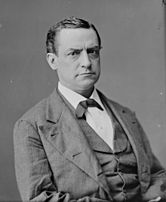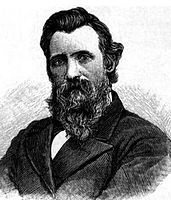1880 United States House of Representatives elections
This article needs additional citations for verification. (April 2013) |
| |||||||||||||||||||||||||||||||||
All 293 seats in the U.S. House of Representatives 147 seats were needed for a majority | |||||||||||||||||||||||||||||||||
|---|---|---|---|---|---|---|---|---|---|---|---|---|---|---|---|---|---|---|---|---|---|---|---|---|---|---|---|---|---|---|---|---|---|
| |||||||||||||||||||||||||||||||||
| |||||||||||||||||||||||||||||||||
Elections to the United States House of Representatives were held in 1880 for Representatives to the 47th Congress, coinciding with the election of President James A. Garfield.
Garfield's Republican Party managed to gain an outright majority of seats from the opposition Democratic Party. The Democratic loss of control in the House is historically seen as somewhat surprising, since no major issue played a role in their defeat. The end of Reconstruction and the pro-business nature of the Republicans were both minor factors. The ability of the Republican Party to paint several key Democratic leaders as corrupt also helped to alter the composition of the part just enough so that the Republicans gained a majority. The Greenback Party, which promoted the use of the paper currency and was seen as a pro-farmer party[by whom?], also lost several seats due to national economic recovery, which aided the Republicans.[citation needed]
Election summaries
| 151 | 10 | 131 |
| Republican | Gb | Democratic |
| State | Type | Total seats |
Republican | Democratic | Greenback | |||
|---|---|---|---|---|---|---|---|---|
| Seats | Change | Seats | Change | Seats | Change | |||
| Alabama | District | 8 | 1 | 6 | 1 | |||
| Arkansas | District | 4 | 0 | 4 | 0 | |||
| California | District | 4 | 2 | 2 | 0 | |||
| Colorado | At-large | 1 | 1 | 0 | 0 | |||
| Connecticut | District | 4 | 3 | 1 | 0 | |||
| Delaware | At-large | 1 | 0 | 1 | 0 | |||
| Florida | District | 2 | 1 | 1 | 0 | |||
| Georgia | District | 9 | 0 | 9[Note 5] | 0 | |||
| Illinois | District | 19 | 13 | 6 | 0 | |||
| Indiana | District | 13 | 8 | 5 | 0 | |||
| Iowa | District | 9 | 8 | 1 | 0 | |||
| Kansas | District | 3 | 3 | 0 | 0 | |||
| Kentucky | District | 10 | 1 | 9 | 0 | |||
| Louisiana | District | 6 | 1 | 5 | 0 | |||
| Maine[Note 6] | District | 5 | 3 | 0 | 2 | |||
| Maryland | District | 6 | 1 | 5 | 0 | |||
| Massachusetts | District | 11 | 10 | 1 | 0 | |||
| Michigan | District | 9 | 9 | 0 | 0 | |||
| Minnesota | District | 3 | 3 | 0 | 0 | |||
| Mississippi | District | 6 | 1 | 5 | 0 | |||
| Missouri | District | 13 | 2 | 7 | 4 | |||
| Nebraska | At-large | 1 | 1 | 0 | 0 | |||
| Nevada | At-large | 1 | 0 | 1 | 0 | |||
| New Hampshire | District | 3 | 3 | 0 | 0 | |||
| New Jersey | District | 7 | 4 | 3 | 0 | |||
| New York | District | 33[Note 7] | 20 | 12 | 0 | |||
| North Carolina | District | 8 | 1 | 7 | 0 | |||
| Ohio[Note 6] | District | 20 | 15 | 5 | 0 | |||
| Oregon[Note 6] | At-large | 1 | 1 | 0 | 0 | |||
| Pennsylvania | District | 27 | 18 | 7 | 2 | |||
| Rhode Island | District | 2 | 2 | 0 | 0 | |||
| South Carolina | District | 5 | 1 | 4 | 0 | |||
| Tennessee | District | 10 | 3 | 7 | 0 | |||
| Texas[Note 6] | District | 6 | 0 | 5 | 1 | |||
| Vermont[Note 6] | District | 3 | 3 | 0 | 0 | |||
| Virginia | District | 9 | 2 | 7[Note 8] | 0 | |||
| West Virginia | District | 3 | 0 | 3 | 0 | |||
| Wisconsin | District | 8 | 6 | 2 | 0 | |||
| Total | 293[Note 7] | 151[1] 51.5% |
131[1][Note 4] 44.7% |
10[1] 3.4% |
||||
Early election dates
In 1845, Congress passed a law providing for a uniform nationwide date for choosing Presidential electors.[2] This law did not affect election dates for Congress, which remained within the jurisdiction of State governments, but over time, the States moved their Congressional elections to this date as well.
In 1880, no states held their elections after Election Day for the first time (California was the last state to hold late elections, in 1878). But 5 states, with 35 seats among them, held their elections before the rest of the states:
All races
| District | Incumbent | Party | First elected |
Result | Candidates |
|---|---|---|---|---|---|
| California 1 | Horace Davis | Republican | 1876 | Lost re-election Democratic Gain |
William Rosecrans (D) 51% Horace Davis (R) 47.3% Stephen Maybell (GB) 1.7% |
| California 2 | Horace F. Page | Republican | 1872 | Re-elected | Horace F. Page (R) 53.6% John R. Glascock (D) 45.7% Benjamin Todd (GB) 0.7% |
| California 3 | Campbell P. Berry | Democratic | 1879 | Re-elected | Campbell P. Berry (D) 51.1% George A. Knight (R) 48.2% A. Musselman (GB) 0.6% |
| California 4 | Romualdo Pacheco | Republican | 1876 | Re-elected | Romualdo Pacheco (R) 45.8% Wallace Leach (D) 45.3% J. F. Godfrey (GB) 8.9% |
| District | Incumbent | Party | First elected |
Result | Candidates |
|---|---|---|---|---|---|
| Florida 1 | Robert H. M. Davidson | Democratic | 1876 | Re-elected | Robert H. M. Davidson (D) 57.2% George W. Witherspoon (R) 42.3% Livingston W. Bethel (I) 0.5% |
| Florida 2 | Noble A. Hull | Democratic | 1878 | Retired Democratic hold |
Jesse J. Finley (D) 52.3% Horatio Bisbee, Jr. (R) 47.7% |
In the 2nd district, Horatio Bisbee, Jr. (R) successfully challenged the election of Jesse J. Finley (D) and was seated June 1, 1882.
| District | Incumbent | Party | First elected |
Result | Candidates |
|---|---|---|---|---|---|
| South Carolina 1 | John S. Richardson | Democratic | 1878 | Re-elected | John S. Richardson (D) 63.3% Samuel J. Lee (R) 36.7% |
| South Carolina 2 | Michael P. O'Connor | Democratic | 1878 | Re-elected | Michael P. O'Connor (D) 58.8% Edmund W. M. Mackey (R) 41.2% |
| South Carolina 3 | D. Wyatt Aiken | Democratic | 1876 | Re-elected | D. Wyatt Aiken (D) 74.1% C. J. Stollbrand (R) 25.9% |
| South Carolina 4 | John H. Evins | Democratic | 1876 | Re-elected | John H. Evins (D) 69.7% A. Blythe (R) 29.3% J. Hendrix McLane (GB) 1.0% |
| South Carolina 5 | George D. Tillman | Democratic | 1878 | Re-elected | George D. Tillman (D) 60.4% Robert Smalls (R) 39.6% |
See also
Notes
- ^ Five states held early elections between June 1 and October 12.
- ^ a b c Dubin (p. 255) counts 147 Republicans, 135 Democrats, 2 Readjusters, 1 Independent Democrat, and 8 Greenbacks at the start of the 47th United States Congress.
- ^ Included 7 Independent Democrats.
- ^ a b Includes 2 Readjuster Democrats elected in Virginia (VA-07 and VA-09), and 1 Independent Democrat elected to GA-09.
- ^ Includes 1 Independent Democrat elected to GA-09.
- ^ a b c d e Elections held early
- ^ a b 1 Independent, J. Hyatt Smith elected to NY-03.
- ^ Includes 2 Readjuster Democrats, elected to VA-07 and VA-09.
References
Bibliography
- Dubin, Michael J. (March 1, 1998). United States Congressional Elections, 1788-1997: The Official Results of the Elections of the 1st Through 105th Congresses. McFarland and Company. ISBN 978-0786402830.
- Martis, Kenneth C. (January 1, 1989). The Historical Atlas of Political Parties in the United States Congress, 1789-1989. Macmillan Publishing Company. ISBN 978-0029201701.
- Moore, John L., ed. (1994). Congressional Quarterly's Guide to U.S. Elections (Third ed.). Congressional Quarterly Inc. ISBN 978-0871879967.
- "Party Divisions of the House of Representatives* 1789–Present". Office of the Historian, House of United States House of Representatives. Retrieved January 21, 2015.
External links
- Office of the Historian (Office of Art & Archives, Office of the Clerk, U.S. House of Representatives)






